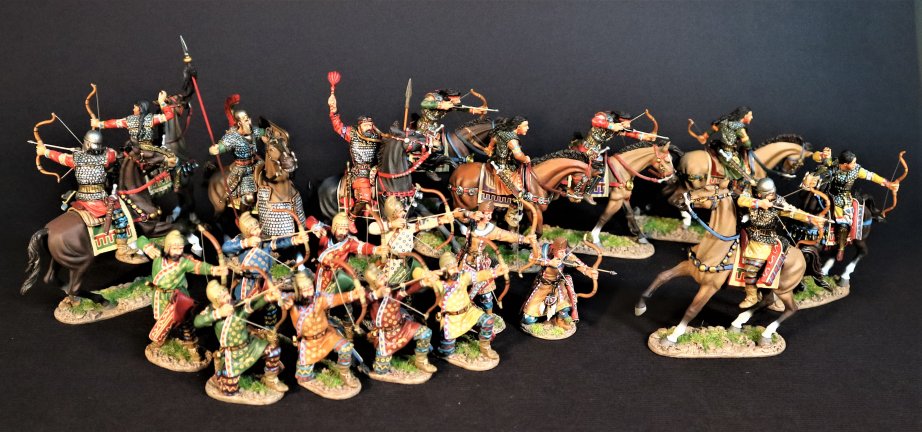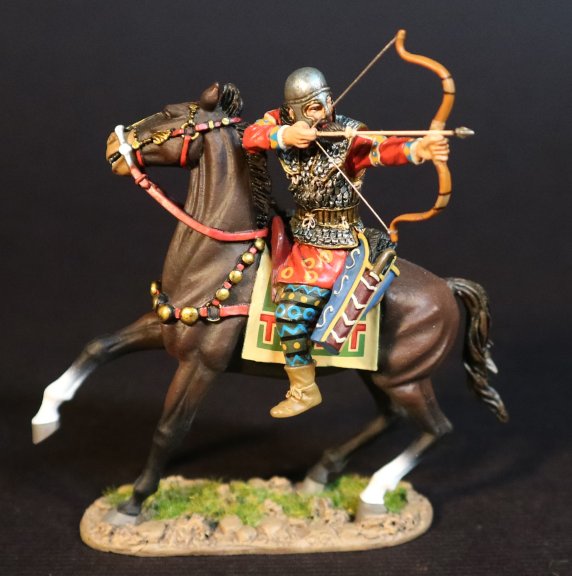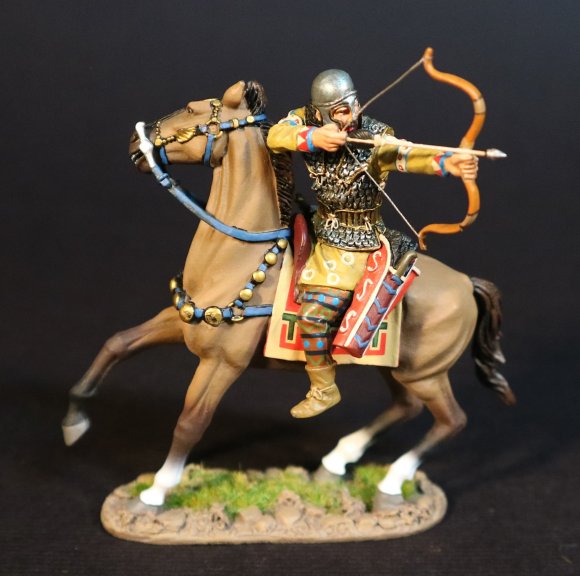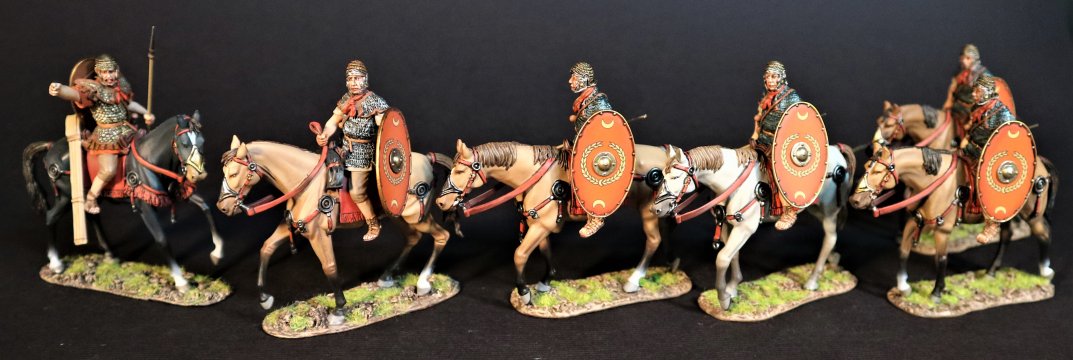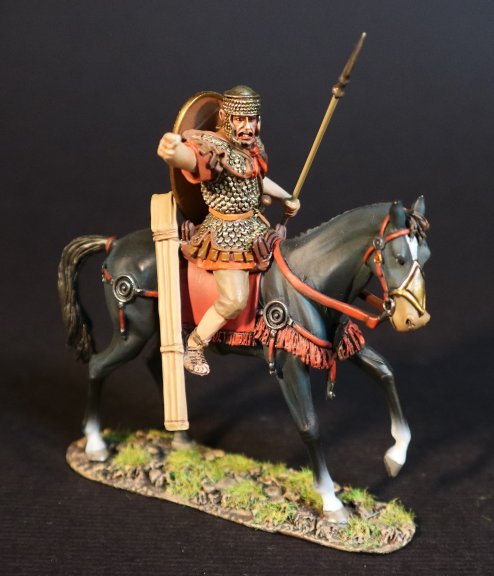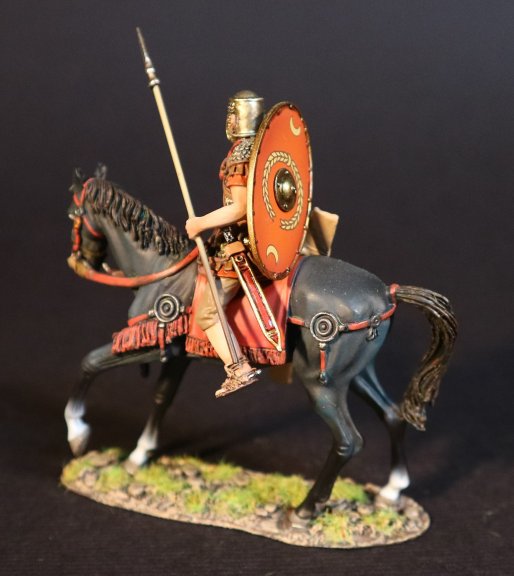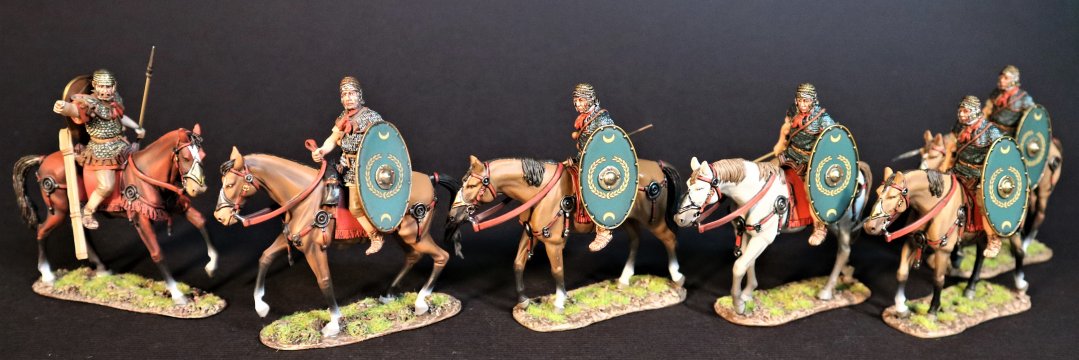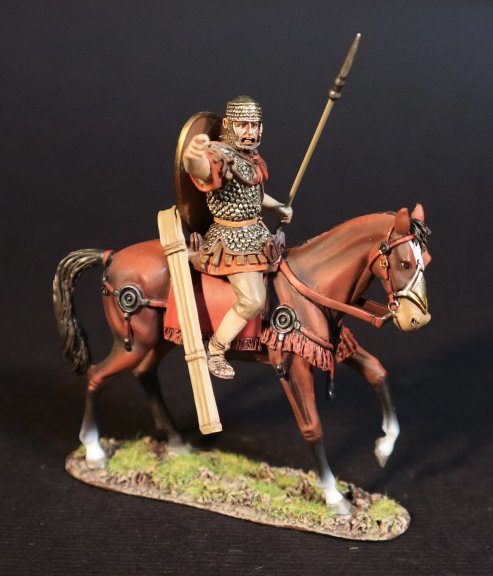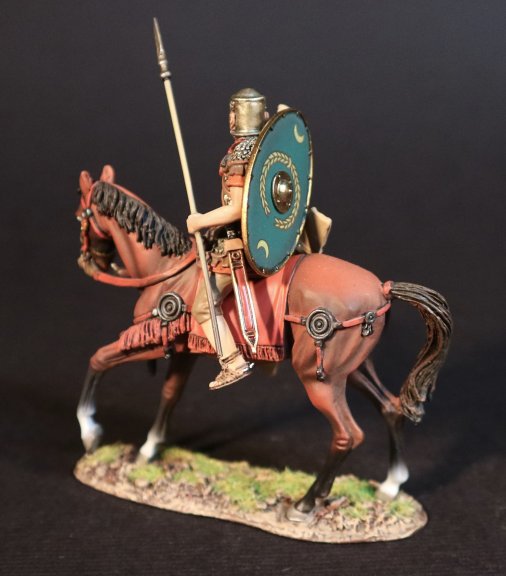- Joined
- Feb 2, 2011
- Messages
- 2,093
NEW RELEASES FOR MARCH 2023
THE ANCIENTS COLLECTION
ARMIES AND ENEMIES OF GREECE AND MACEDONIA
THE MACEDONIAN PHALANX
The Macedonian phalanx was an infantry formation developed by Philip II and used by his son Alexander the Great to conquer the Achaemenid Empire and defeat armies of other kingdoms.
Phalanxes remained dominant on battlefields throughout the Hellenistic period, until they were ultimately displaced by the Roman Legions.
In 359 BC the Macedonian army led by the king Perdiccas III, was decidedly defeated by the Illyrians. Perdiccas’ brother Philip II had been a hostage in Thebes for much of his youth, and what he had learned influenced his restructuring of the Macedonian infantry.
Philip’s military reforms were a new approach to the current hoplite warfare, which focused on their shield and thrusting spear.
Philip’s new focus was on a new weapon, the Sarissa. He called the soldiers in the phalanx Pezhetairoi, meaning “foot companions”.
Each phalangite carried as his primary weapon a Sarissa, a double pointed pike over 18 foot in length. The Sarissae were carried in two pieces before a battle and then slid together when they were to be used.
At close range such weapons were of little use, but an intact phalanx could easily keep its enemies at a distance. The weapons of the first few rows of men all projected beyond the front of the formation, so that there were more spear points than available targets at any given time.
Men in rows behind the initial rows angled their sarissae at angles in an attempt to ward off arrows or other projectiles.
There was a secondary weapon called a xiphos, which was a short sword.
They also had a smaller and flatter shield than that of the Greek Hoplon. The shield was worn hung around the neck so as to free up both hands to wield the sarissa.
The Phalanx consisted of several blocks of men, called syntagmata. There were 16 of these with 16 men in each Syntagmata. Each block was commanded by a syntagmatarchy, who together with his subordinate officers would form the first row of each block.
Neither Philip or Alexander actually used the phalanx as their arm of choice, but instead used it to hold the enemy in place while their heavy cavalry broke through the enemy ranks.
The Macedonian cavalry fought in a wedge formation and was almost always stationed on the far right.
The hypaspists an elite infantry unit were stationed on the immediate right of the phalanx wielding hoplite sized shields and spears.
The left flank was generally covered by allied cavalry usually Thessalians, which fought in a rhomboid formation and served mainly in a defensive role.
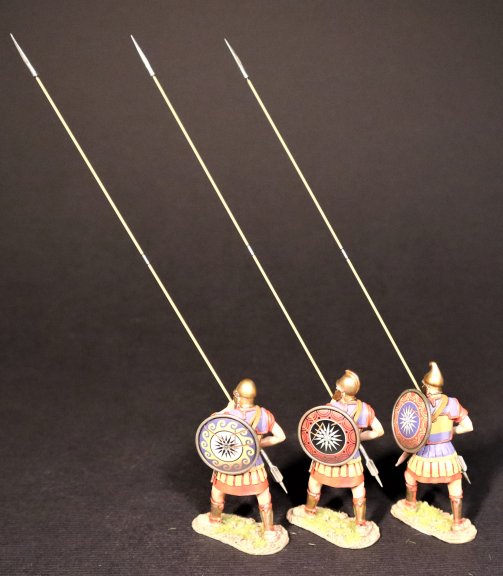
MAC-06A
ARMIES AND ENEMIES OF ANCIENT GREECE AND MACEDONIA,
THE MACEDONIANS,
MACEDONIAN PHALANX,
3 PHALANGITES WITH COLOURED SHIELDS
(6 pcs)
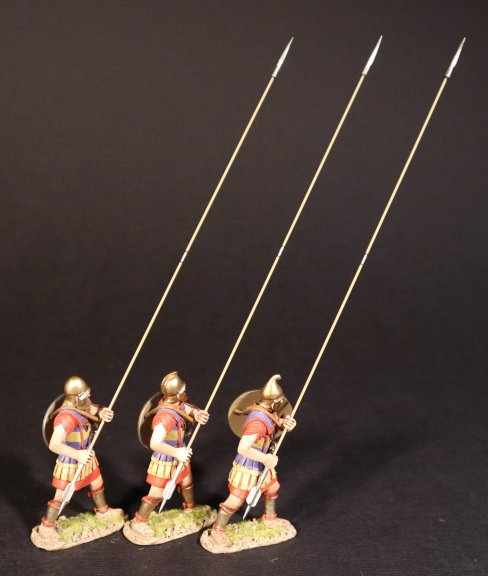
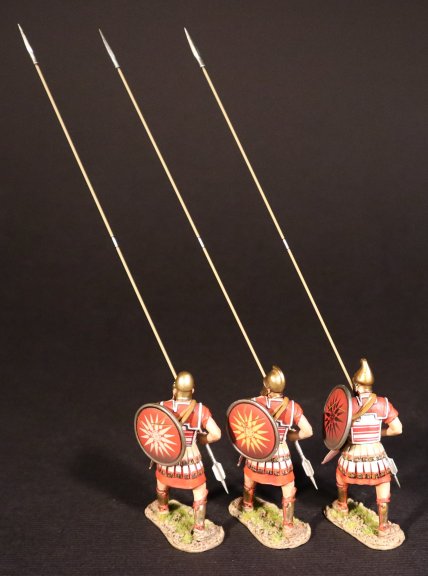
MAC-06B
ARMIES AND ENEMIES OF ANCIENT GREECE AND MACEDONIA,
THE MACEDONIANS,
MACEDONIAN PHALANX,
3 PHALANGITES WITH RED SHIELDS
(6 pcs)
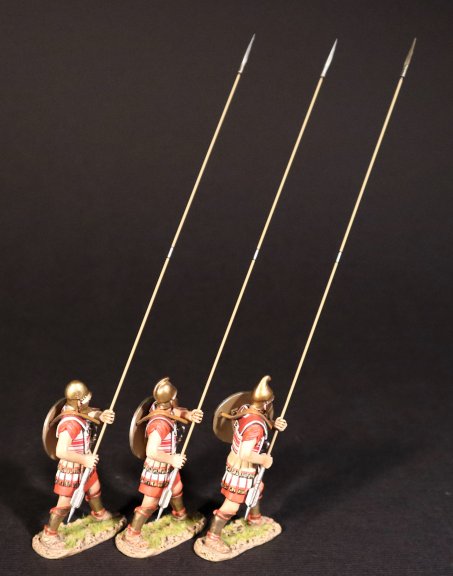
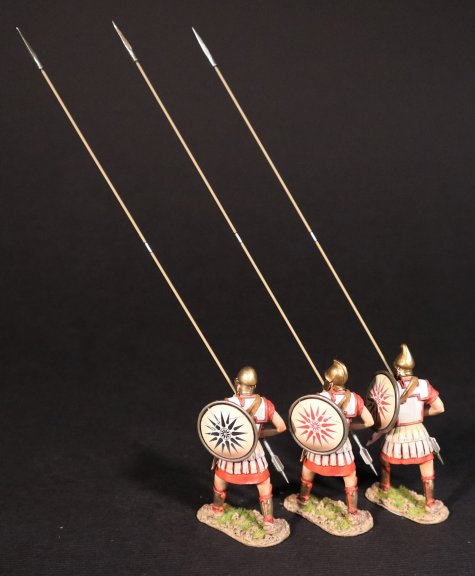
MAC-06C
ARMIES AND ENEMIES OF ANCIENT GREECE AND MACEDONIA,
THE MACEDONIANS,
MACEDONIAN PHALANX,
3 PHALANGITES WITH WHITE SHIELDS
(6 pcs)
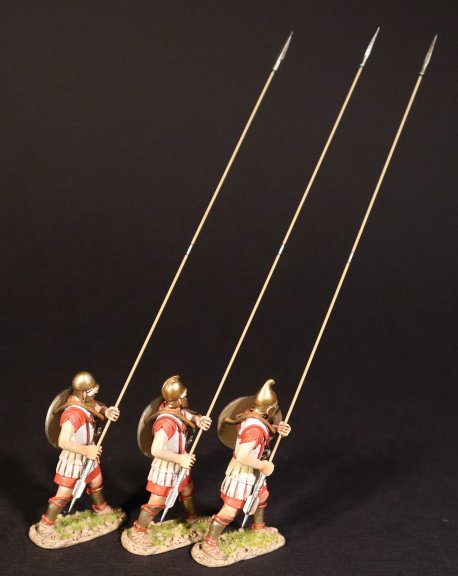
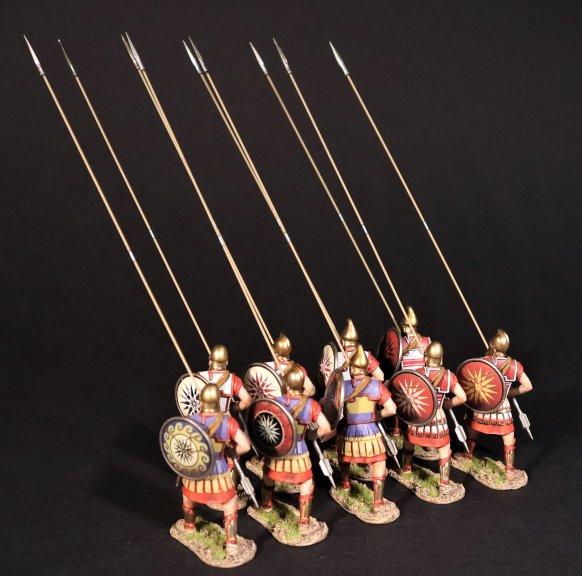
MAC-06N2
ARMIES AND ENEMIES OF ANCIENT GREECE AND MACEDONIA,
THE MACEDONIANS,
MACEDONIAN PHALANX,
9 PHALANGITES.
(18 pcs)
THE ANCIENTS COLLECTION
ARMIES AND ENEMIES OF GREECE AND MACEDONIA
THE MACEDONIAN PHALANX
The Macedonian phalanx was an infantry formation developed by Philip II and used by his son Alexander the Great to conquer the Achaemenid Empire and defeat armies of other kingdoms.
Phalanxes remained dominant on battlefields throughout the Hellenistic period, until they were ultimately displaced by the Roman Legions.
In 359 BC the Macedonian army led by the king Perdiccas III, was decidedly defeated by the Illyrians. Perdiccas’ brother Philip II had been a hostage in Thebes for much of his youth, and what he had learned influenced his restructuring of the Macedonian infantry.
Philip’s military reforms were a new approach to the current hoplite warfare, which focused on their shield and thrusting spear.
Philip’s new focus was on a new weapon, the Sarissa. He called the soldiers in the phalanx Pezhetairoi, meaning “foot companions”.
Each phalangite carried as his primary weapon a Sarissa, a double pointed pike over 18 foot in length. The Sarissae were carried in two pieces before a battle and then slid together when they were to be used.
At close range such weapons were of little use, but an intact phalanx could easily keep its enemies at a distance. The weapons of the first few rows of men all projected beyond the front of the formation, so that there were more spear points than available targets at any given time.
Men in rows behind the initial rows angled their sarissae at angles in an attempt to ward off arrows or other projectiles.
There was a secondary weapon called a xiphos, which was a short sword.
They also had a smaller and flatter shield than that of the Greek Hoplon. The shield was worn hung around the neck so as to free up both hands to wield the sarissa.
The Phalanx consisted of several blocks of men, called syntagmata. There were 16 of these with 16 men in each Syntagmata. Each block was commanded by a syntagmatarchy, who together with his subordinate officers would form the first row of each block.
Neither Philip or Alexander actually used the phalanx as their arm of choice, but instead used it to hold the enemy in place while their heavy cavalry broke through the enemy ranks.
The Macedonian cavalry fought in a wedge formation and was almost always stationed on the far right.
The hypaspists an elite infantry unit were stationed on the immediate right of the phalanx wielding hoplite sized shields and spears.
The left flank was generally covered by allied cavalry usually Thessalians, which fought in a rhomboid formation and served mainly in a defensive role.

MAC-06A
ARMIES AND ENEMIES OF ANCIENT GREECE AND MACEDONIA,
THE MACEDONIANS,
MACEDONIAN PHALANX,
3 PHALANGITES WITH COLOURED SHIELDS
(6 pcs)


MAC-06B
ARMIES AND ENEMIES OF ANCIENT GREECE AND MACEDONIA,
THE MACEDONIANS,
MACEDONIAN PHALANX,
3 PHALANGITES WITH RED SHIELDS
(6 pcs)


MAC-06C
ARMIES AND ENEMIES OF ANCIENT GREECE AND MACEDONIA,
THE MACEDONIANS,
MACEDONIAN PHALANX,
3 PHALANGITES WITH WHITE SHIELDS
(6 pcs)


MAC-06N2
ARMIES AND ENEMIES OF ANCIENT GREECE AND MACEDONIA,
THE MACEDONIANS,
MACEDONIAN PHALANX,
9 PHALANGITES.
(18 pcs)


